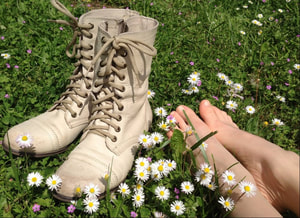
All this got me thinking of the Earth and what my experience of it is. I recall myself as a young child running around without shoes in the garden, my mother calling out to me to put on my shoes to protect my feet. She told me at some point too that worms, can go through my feet to infest my body. That sure made an impact on me, so I put on my shoes to walk outside even until adulthood, especially in the tropics. She was correct that some worms, such as hookworms do that. But I have also now learned to go barefoot too, on the sand at the beach, on river rocks and on grass. I realise that I was missing a whole tactile world under my feet when I closed my feet off in socks and shoes, not to mention the sunlight and fresh air. My family and I are often barefoot inside our house, which is how most Asians live inside their homes. My partner is more so the barefoot-person outside but I'm learning to do that and sensing much more with my feet.
Then a few weeks ago, I just watched a documentary, The Earthing Movie: The Science of Grounding. I really recommend it. It is about how the Earth heals us when we connect with it, from a scientific point of view. It wasn't just your imagination when you took your shoes off, went barefoot on the grass in the park and felt so much better. Science is showing us that the negative-charged electrons are being absorbed through your feet and into your body, to neutralize Electromagnetic Field (EMF) radiation that have been absorbed into our body. It is extremely effective for healing inflammation. The movie explains the science, the studies, the whole theory behind how it works and also shows people who have experienced the benefits of Earthing. There is also a book called, "Earthing," which further explains it and available in many languages including German. Basically, Earthing is free and we can all do it without having anything to lose. Just go outside, take off your shoes, be barefoot and begin connecting to the Earth. No excuses, it's warm outside.
Image Earth by WikiImages on Pixabay
Image Barefoot by Jackie_Chance on Pixabay

 RSS Feed
RSS Feed